Or….And then we found ourselves behind a truck whose blinker actually meant he was turning left! How confusing was that!
We left you in Patzcuaro. What a wonderful city; we have a special fondness for this lovely, inviting town. We could easily have spent the entire winter, we feel so comfortable there. And some year we might. But right now we want to keep pushing the envelope, and continue to see new areas of Mexico. So what do these two idiotas do? We head back to the beach….and to our original plan, which was to go down and around, along the south coast, until we got south of Oaxaca, and then head back up into the mountains to see that lovely city. And so that’s what we’ve been up to. You may remember that we left the beach because it was so damn hot. But back we went anyway. And it was still too damn hot for us.
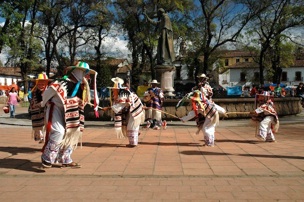
Patzcuaro is at an altitude of a bit over 6800 feet; we were heading for the coast and very quickly dropped to 1700 feet, into lush tropical foliage and the pretty little town of La Huacana. We were definitely off the beaten track here, having chosen to take a lesser road to the coast. The fellow in the truck next to us when we were getting fuel had half a pig hanging on a hook over the side of his truck; he casually shoved it aside in order to get to the gas tank. Local color…..
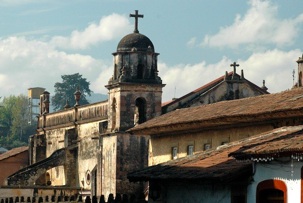
At the coast, we left the state of Michoacan and entered Guerrero. We had hoped to spend the night on the beach near a turtle sanctuary. We had heard it was very interesting; the turtles were laying their eggs in the sand, and volunteers were helping by digging the eggs up and carrying them to safety, then later helping the little guys get oriented toward the water after hatching. But we’d gotten a late start in the morning (all that backing up and “oops”-ing in Patzcuaro), and had to opt to visit the turtles another time. This was the second time I’d had to forego a Trip to the Tortugas (humph). The first time had been on the Baja; the sanctuary near where we were camped was simply never open to be visited.
We worked our way further down the coast to La Saladita, which had come highly recommended. We were not disappointed. Picture wide beaches, palm trees, and sunny skies. Think Santa Barbara – without the people or the town. That’s La Saladita. We spent a quiet night parked on the beach, between two palapa restaurants, with a lovely breeze keeping the hot humid air from being oppressive. There were a resident horse and burro who wandered around, unfettered, first one in the lead and then the other. Idyllic.
Back on the road, we now were seeing coconuts at roadside stands everywhere. The land of the coconuts, it seemed; and very tropical now, as long as we were right on the coast. Coco palms, banana palms, lush vegetation, bougainvillea. Roosters and pigs running loose in every little town. And the road goes through every single one of them. We like this; we’re not in a hurry and it’s very picturesque, though also very tiring by the end of the day. We rode along conjugating Spanish verbs as we dodged the goats and pigs, the oncoming traffic, passing the big huge trucks with aplomb, and bumping over the topes.
The road doesn’t just go along the coast; it goes inland over the hills that border the coastline, and when you get inland a bit, it gets very dry and arid. Then back to the shoreline, and drippy wet again. The fridge cannot handle this. Turned up all the way, it gasps trying to keep things cool. Not helped by Kathy, who sincerely feels that each produce stand along the way deserves her serious attention. Watermelon; oranges and tangerines for juice; grapefruit; and oh, look, there’s a big beautiful pineapple. Finally, says Rick: No Mas Frutas!!!!! Kathy scowls, but subsides.
We stopped for the night in Acapulco. Nothing good to say here. We took the bypass road up into the hills and around much of the city, but that didn’t help. It brought us down into town through the working class underbelly of this huge resort city. You could only feel sorry for all these poor folks scurrying to work each day in the big hotels we could see lining the shore. But enuff; it was hot and humid, we spent the night and got the hell out of town the next morning. We did, I confess, splurge on Domino’s Pizza.
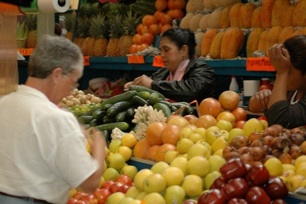
And soon, here we were, in the state of Oaxaca, and once again along the water. This part of the south coast has lagoons; a couple of major ones are now sanctuaries, and are ecotourism destinations. Too buggy and snake-y for our taste, but we spent our last night on the coast along the edge of Laguna Manialtepic, kind of a cool spot, close to Puerto Escondido. We were in a small campground with few amenities except direct access to the lagoon. It was run by a nice old fellow who lived in the middle of this swamp, in a funky old house slowly being overrun by vines and banana palms. A charmer, he said he’d about given up the property a few years back because of a lack of fresh water. But then they had an earthquake, and ever since, he’s had plenty of good spring water, so he guesses he’ll stay on.
And then, happy to be heading into the mountains and toward cooler climes, we headed back up the hill. Destination: Oaxaca City. Oaxaca is at about 5100 feet, but to get there you go up to 6500 feet, then down again, then to 7000 feet then down, then to 6200 then down then up to 5000 and Oaxaca valley. The refrigerator was having fits. On our way up we went through coffee-growing areas, forests, desert-like areas; it was quite a trip on a very snake-like road. Do you know what a URO is? That’s an Unidentified Rolling Object, typically citrus in nature; we had lots of them in the coach as we went around all those curves.
On one occasion we passed a procession of people on pilgrimage to a famous small town. Their cars were decorated with flowers, or they walked along carrying religious things; there were even a few semi-trucks, all decorated with palm fronds and paper snowflakes. It was quite a scene.
Brightly painted beehives were along the roads in several places. We are all used to seeing white boxes alongside the road, or back under the trees; these were all the colors of the rainbow, making quite a picture.
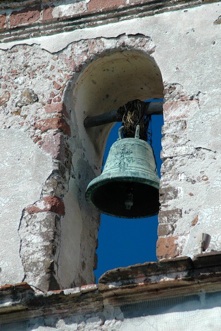
To get into the city you take this crazy bus ride. Some of the roads are paved, all of them are very narrow, and then you get into the city proper. And there’s traffic galore. And the bus driver is trying to make up time from when he stopped at the tienda to get a munchie to help him through the morning. So here comes Mr. Toad’s Ride again. It was a gas.
It took us a couple of trips into town to get comfortable with Oaxaca. We so love Patzcuaro, and are so comfortable there. Oaxaca is much bigger; the square seems strangely sterile and plain to us; but we discovered that the markets are even more colorful; and the merchandise is certainly lovely. So we fell in love all over again. Oaxaca has rugs. We own two that came from this area (Teotitlan, actually, which is quite close by); and we were happy to spend two great days wandering into each doorway, visiting each small hole in the wall with rugs hanging outside, looking at all the beautiful tapetes (rugs) and wishing we could buy them all. We also sampled the local coffee, bought the local chocolate, and ate the local dishes. We have met Oaxaca and it is ours.
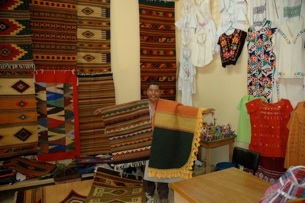
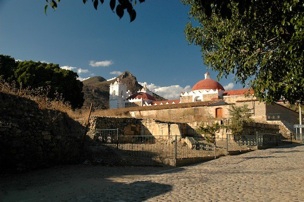
We had a ball. All the family came to meet us; mama was busy carding wool, dad was spinning the yarn, two brothers were making rugs, and Angela ground various plants to make dyes for us to see. They even get the wool from their own sheep. It was fascinating. We spent the afternoon with them; Angela spoke good English and one brother also worked in the local community museum, so we were able to easily communicate. The upshot of all this, of course, was that we wanted to buy a rug. We picked out one we liked, but Angela said she had more in her shop on the square; so we trooped back down the hill again. Mama came with us this time, and both she and Angela couldn’t stop talking about how lovely our coach was, with the kitchen and bathroom and so much space. As always, we tried to downplay how our home made us appear so rich, but it never gets us very far. It’s awkward. No matter how small and simple, what we have is so much more than they do.
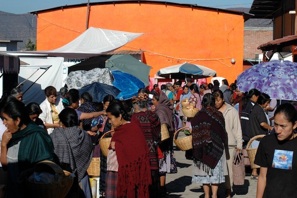
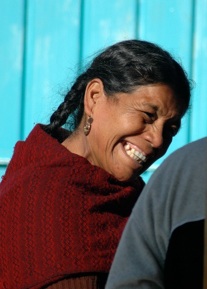
Moving on: You may know that Mexico is full of two big things: volcanoes and ruins. Many of them are in central Mexico, in the area around the capital city. Our route for the next few weeks was designed to take us on a loop around Mexico City, first east and then north, and then back toward the western part of the country. And we would be passing both volcanoes and ruins. We decided to get a ruin-fix, and visited Mitla, close to Teotitlan; it was one of the biggies, but not nearly as impressive as we had hoped. So we snapped a few pics, dodged the nice folks trying to sell us beads and blouses and other stuff, and took off, on to Puebla.
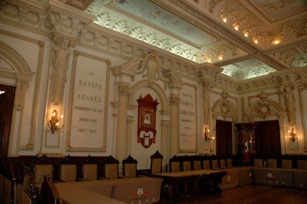
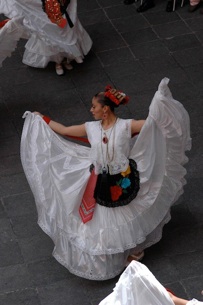
When Cortes invaded Mexico, he destroyed every temple he found, and built a church on the ruins. In Cholula, “the ruins”, constitute the largest archeological site in the western hemisphere. No kidding! What appears to be a hill is actually a labyrinth of corridors connecting several layers of religious sites from prior civilizations. We declined to take the guided tour through the underground area, but knowing it was all down there was neat, and the view from the top is quite spectacular, almost worth the climb (says Rick). You can see four volcanoes, the aforementioned Popocatepetl, plus Iztaccihuatl, La Malinche, and Pico de Orizaba (as if you cared…). They ring the valley that contains Puebla.
This valley also contains another city which was an unexpected delight: Tlaxcala (in the state of the same), which is northeast of Mexico City, and a real beauty. It has its own rich colonial heritage, and the city has been lovingly restored. The local stone is quite a vivid ochre color, and we were able to get some nice pictures. We spent about half an hour talking to a group of university students. They quite apparently had been given an assignment in their English class to talk to English-speaking tourists. So they accosted us and asked us questions and we had a great chat. We had had a similar experience in Puebla while at the dance performance. We suspect that all students at all universities are given similar tasks. It was lots of fun; the kids were charming and giggly and full of high spirits. And they seemed genuinely curious about us, our interests, and our plans. A great cultural connection, if fleeting.
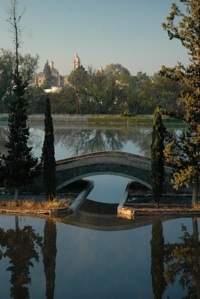
The next morning we started out on the road toward Pachuca, which would take us north of Mexico City, and head us west toward Queteraro and then San Miguel. We went up over 9500 feet, through a broad pine-covered valley that was mostly used for grazing sheep; it was very pretty. We decided that the State of Tlaxcala was a hidden treasure. No one ever talks about it or suggests it as a tourist destination. And we aren’t going to mention it to a soul (except you, of course!). We went through several lovely small cities; we congratulated ourselves on our choice of routes, and how smart we were to be so far off the beaten track.
And then… the road basically ended. By now we had left Tlaxcala behind, had negotiated the large city of Tulancingo, and were headed for Pachuca. I was busy being pleased that the road was brand new and so much better than the map had indicated, when…it stopped being a road. Damn! They were busy building more of this “new road,” and had torn up much of the old one. And no signs saying the road was closed. Sometimes we traveled on dirt, sometimes we were on sections of old road, sometimes we were in the middle of nowhere with no indication of what to do next. But every once in awhile someone would come at us from the other direction, so we knew we could get through if we just kept going. And every once in awhile we passed some workers, and they never started waving their hands and telling us not to go on (and they weren’t giggling and pointing at us, either, which was comforting). For better or worse we were following a couple of trucks. Couldn’t tell what kind, until they turned off into a pit and we realized they were dump trucks for the road work. After they had abandoned riding “point,” and we were on our own, we felt lonely but courageous. And eventually, after about 15 miles, we met the finished road and toodled merrily (not really) on our way. What an exhausting adventure. We found a place to pull over for the night, and sat licking our wounds as we muttered about “the Mexican way.”
Interesting: now that we had left Oaxaca, and had moved into more urban, industrialized parts of Mexico, we no longer encountered any road blocks. Guess there are no drugs, guns or terrorists here…
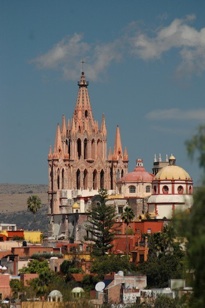
Mexican lessons for the day – yonke; a yonke is a junk yard. And a vulcanizadora is a tire repair place; it always reminds me of Isadora Duncan.
Interesting custom in large cities (we saw it several places): people don’t put out their trash the night before the garbage truck comes; instead, a person ringing a bell precedes the truck, letting everyone know it’s time to come bring their trash out to be removed. Seems to me this is eminently practical; we saw it both in the business areas and among residences. Pretty neat, we’d say. Ring… and then the trashman cometh.

What a lovely city! Just like in Oaxaca, again we were in a little campground above the town, looking down on it all. We were so glad we had come, and immediately walked down into town (closer to the action this time), spending the afternoon getting our bearings and enjoying the sights. We planned to stay a week or so, before heading back into the States to take care of encroaching issues.
But the issues continued to encroach, and ultimately we realized that we needed to head out, if we were going to be able to handle things as we wished. Frankly, for some time we had realized that our goals were evolving. Traveling in the Chinook had convinced us that small RVs are the way we want to travel, and increasingly over the last several months we have been talking about heading further afield, and the manner in which we wanted to do this. All winter, we have been meeting folks heading to Central America, or coming north after being in South America, and two different couples who were starting trips around the world! And we realized that we wanted to do that, too. But what would be the best vehicle for this several-year trip? We thought it might be the Chinook, although that had some downsides, the biggest being its age, very limited ground clearance and the fact that it has a gas rather than a diesel engine. So Rick researched what other options we had, and came up with a couple of good alternatives. One we were very interested in was a small company operating out of Columbia, South Carolina, which made the Tiger, a small chassis mount camper on a Chevy truck chassis; another was Sportsmobile, in Austin, TX, making conversions on the Mercedes-Benz van chassis. Both diesel, both innovative in their design, both quite intriguing. A conversation with the company owner in South Carolina got us moving right along. He said he was about finished with the 2006 trucks he was going to be able to get, and the 2007s were going to have the ultra-low-sulfur diesel fuel requirement (more on this later). So if we were interested in his product, we should think about coming to look pretty soon.
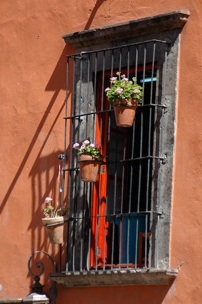
By the way, about the ultra-low-sulfur diesel fuel. You know we are very sensitive to environmental issues; always have been. We applaud the United States for joining Europe in adopting this new requirement; if we were going to stay here we would be delighted to become involved. But (and this is a huge thing), the developing countries where we are headed are not ready to provide us with this new fuel and may not be for years to come. We’ve been told that an occasional few gallons of the “wrong” stuff won’t do damage, but that larger amounts will result in costly repairs; and what about entire countries (or continents!) that don’t have any – anywhere? So that’s why it was so important to us to buy one of the older engines.
You can read more about the Tiger on our Our Vehicle page; we hope you will look at it there, at least until we can show you in person. We hope to see many of you on the West Coast this spring, or maybe in the Mid-West in the fall. It’s going to be a great year!
Hasta la vista,
Rick and Kathy, your crazy-intrepid-spontaneous-impulsive-justplainweird wandering amigos.
Click here for more pictures from Mexico.






